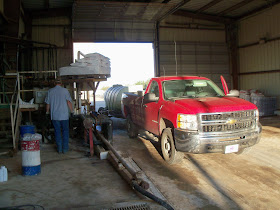 S'More Cookie Bars give you the taste of the campfire without having to light a match. Of course, you will have to light your oven.
S'More Cookie Bars give you the taste of the campfire without having to light a match. Of course, you will have to light your oven.Jill and I both spotted this recipe on a Facebook update from Mandy, my cousin's daughter. It was the weekend of the move. After unpacking dozens of boxes, we were taking a break. Jill was on her computer and I was on mine. We had to laugh when we both pulled up the recipe at the same time.
"Mmmmm ... that looks good," we said, practically at the same time.
And we were right. I recently made them for a Nu Lambda potluck. Randy taste-tested them before they went out the door and told me they should stay home, since they weren't company worthy.
But I saw through the ruse. He just wanted them all for himself. Never fear: My Nu Lambda friends left some, and he gladly cleaned up the leftovers.
Enjoy!
S'More Cookie Bars
1/2 cup butter, room temperature1/4 cup brown sugar
1/2 cup granulated sugar
1 large egg
1 tsp. vanilla extract
1 1/3 cups all-purpose flour
3/4 cup graham cracker crumbs (about 8 graham crackers)
1 tsp. baking powder
1/4 tsp. salt
2 king-sized milk chocolate bars
7 oz. jar marshmallow creme
Preheat oven to 350 degrees. Spray an 8-inch-square baking pan with cooking spray. In a large bowl, cream butter and sugars until light. Beat in egg and vanilla.
In a small bowl, whisk together flour, graham cracker crumbs, baking powder and salt. Add to butter mixture and mix at a low speed until well combined. Divide dough in half. Press half into an even layer on the bottom of the prepared pan.
Unwrap chocolate bars and place over dough. Don't layer the bars; just break them to fit if you need to. Spread the marshmallow creme over the chocolate bars. With the remainder of the cookie dough, press the dough into "sheets" with the palm of your hand and lay it on top of the marshmallow fluff. Don't worry if the dough isn't covering everything because it will spread as it bakes.
Bake for 30 to 35 minutes or until lightly browned. If the top browns too quickly, cover it with foil for part of the baking time. Cool completely before cutting into bars. If you don't allow them to cool, they will crumble when you try to cut them. Makes 16-20 bars.
For more photos, check out the recipe on Crepes of Wrath, the site where Mandy discovered these delicious bars!















































